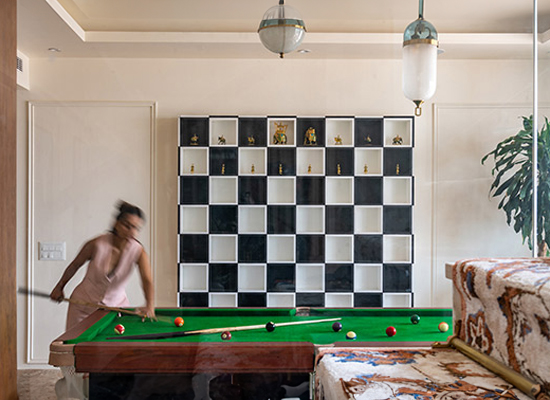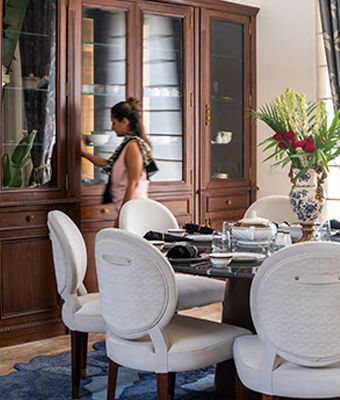Part 2 - Tips for Maximizing Natural Light in Your Home | Bhina Wolf Atelier
Trim Back Outdoor Foliage:
Trimming back outdoor foliage is an effective way to maximize natural light in your home. Overgrown trees, shrubs, and bushes can block sunlight from entering your windows, reducing the brightness of your indoor spaces. Here's how to trim back outdoor foliage strategically to improve natural light:
Identify the Areas to Trim:
Start by identifying the specific areas where overgrown foliage is blocking natural light from entering your home. Pay close attention to windows, doors, and skylights.
Timing:
Plan your trimming during the appropriate season. Late winter or early spring is often a good time for pruning many plants, as they are dormant, but specific timing can vary depending on your location and the type of plants you have.
Safety Precautions:
Wear protective gear, such as gloves, safety glasses, and sturdy clothing, to protect yourself from thorns, branches, and debris. Use a sturdy ladder if needed and work with someone else for safety.
Choose the Right Tools:
Select the appropriate tools for the job. Common tools for trimming outdoor foliage include pruning shears, loppers, hedge trimmers, and a saw for larger branches. Make sure your tools are sharp for clean cuts.
Pruning Techniques :
Use proper pruning techniques. Start by removing dead or damaged branches. Then, selectively trim back branches that are blocking sunlight. Focus on areas near windows and other light sources.
Maintain Natural Shapes :
When pruning, try to maintain the natural shape of the plants as much as possible. This will not only improve aesthetics but also ensure the plants continue to thrive.
Avoid Over-Pruning :
Be cautious not to over-prune, as this can harm the plants. Over-trimming may lead to sparse growth and an unhealthy appearance.
Gradual Trimming :
Be cautious not to over-prune, as this can harm the plants. Over-trimming may lead to sparse growth and an unhealthy appearance.
Gradual Trimming :
If your plants are significantly overgrown, consider trimming them back gradually over time. This approach minimizes the shock to the plants and allows them to recover.
Remove Overlapping Branches :
Look for branches that overlap and create dense canopies. By removing overlapping branches, you can improve air circulation and allow more sunlight to reach your windows.
Thin Out Dense Foliage :
Thin out dense foliage by selectively removing branches and leaves. This will help sunlight penetrate the canopy and reach your home's interior.
Consult a Professional :
If you are unsure about how to trim specific plants, or if you have large trees that require pruning, consider consulting a professional arborist or landscaper. They can provide expert guidance and ensure the safety of your trees and shrubs.
Trimming back outdoor foliage strategically allows natural light to flow into your home, creating a brighter and more inviting atmosphere. Additionally, it helps maintain the health and appearance of your outdoor landscaping. Proper pruning and maintenance can strike a balance between a well-lit indoor space and an aesthetically pleasing outdoor environment.
Paint with Light Colors:
Painting your interior with light colors is an effective way to maximize natural light in your home. Light-colored walls, ceilings, and furniture can reflect and enhance the natural light, creating a bright and airy atmosphere. Here are some tips for using light colors to optimize natural light:
Choose Light Paint Colors:
Select light and neutral paint colors such as whites, off-whites, light grays, pastels, and soft beiges. These colors reflect light and make spaces feel more open.
White Ceilings:
Painting your ceiling white or a very light color can help bounce light around the room, making it feel more spacious. White ceilings also create the illusion of higher ceilings.
Keep Trim and Moldings Light:
Choose light-colored trim, moldings, and baseboards to provide a clean and seamless transition from the walls to these architectural elements.
Monochromatic Schemes:
Consider using a monochromatic color scheme, where different shades of the same color are used for walls, trim, and ceilings. This creates a sense of continuity and maximizes the light.
Light-Colored Flooring:
If you're installing new flooring, choose light-colored options like light wood, light gray or beige tiles, or pale carpets. Light flooring reflects natural light and contributes to a brighter space.
Reflective Finishes:
Opt for paint with a semi-gloss or satin finish. These finishes are more reflective than flat or matte paints and can help bounce light around the room.
Accent Wall in a Light Color:
If you want to add a pop of color, consider painting one accent wall in a light or pastel shade. This can create a focal point without compromising the overall brightness.
Large Windows:
If possible, increase the size of your windows or install additional windows to allow more natural light into your space. Light-colored walls will amplify the effect of larger windows.
Use Mirrors:
Place mirrors strategically to reflect and amplify natural light. Mirrors can also make spaces appear larger.
Accessorize with Light Decor:
Choose light-colored furniture, textiles, and decor items. Light upholstery, curtains, and rugs can complement your light-colored walls and complete the bright, airy look.
Avoid Dark Contrasts:
Minimize the use of dark contrasting colors on walls, as these can absorb light and create a heavier atmosphere. Instead, use darker colors sparingly as accents.
Coordinate with Natural Materials:
Light colors can pair beautifully with natural materials like wood, stone, and jute. The combination of light walls and natural textures creates a warm and inviting environment.
Keep It Balanced:
While light colors can enhance natural light, ensure that your space doesn't become too sterile. Introduce varying shades and textures to create depth and interest.
By incorporating light colors into your home's interior design, you can create a bright, welcoming, and open space that makes the most of the natural light available. It not only enhances the visual appeal of your home but also contributes to a cheerful and pleasant living environment.
Minimalist Furniture:
Minimalist furniture is an excellent choice for maximizing natural light in your house. Its clean lines, simple design, and uncluttered appearance help create a bright and open atmosphere. Here's how to use minimalist furniture effectively to enhance natural light:
Choose Streamlined Designs:
Opt for furniture pieces with clean and simple lines. Avoid bulky or ornate designs that can block natural light and make the space feel heavy.
Light Colors:
Select furniture in light colors, such as white, light gray, beige, or pastels. Light-colored furniture reflects and amplifies natural light, making the room appear brighter.
Low Profile:
Look for low-profile furniture, including sofas, coffee tables, and chairs. Lower furniture pieces create a sense of openness and allow light to travel further into the room.
Open Shelving:
Consider open shelving units with minimalist designs. These units maintain an airy feeling and allow light to pass through, enhancing the brightness of the space.
Glass and Acrylic Furniture:
Incorporate glass or acrylic furniture items, such as glass coffee tables or acrylic dining chairs. These materials are transparent, allowing light to pass through and making the room feel less crowded.
Multi-Functional Pieces:
Choose furniture that serves multiple purposes to reduce clutter. For example, a sofa bed can function as a seating area during the day and a guest bed at night.
Modular Furniture:
Modular furniture can be customized to fit your space and needs. It's a minimalist way to optimize the use of the room and allow light to flow freely.
Small-Scale Furniture:
In smaller rooms or spaces with limited natural light, opt for smaller-scale furniture to avoid overwhelming the area with bulky pieces.
Reduce Clutter:
Embrace the "less is more" philosophy by minimizing the number of furniture pieces and decor items in your space. A clutter-free environment allows light to circulate freely.
Maintain Symmetry:
Arrange your minimalist furniture in a balanced and symmetrical layout. A well-organized space appears more spacious and inviting, and it allows natural light to reach every corner.
Reflective Surfaces:
Incorporate furniture with reflective surfaces, such as polished metal or mirrored accents. These materials can enhance the play of light in the room.
Incorporate Natural Materials:
Consider minimalist furniture made from natural materials, such as wood or bamboo. These materials add warmth and texture while still maintaining a minimalist aesthetic.
Quality Over Quantity:
Invest in high-quality, timeless pieces of furniture rather than numerous lower-quality items. Quality furniture tends to have a more lasting and elegant appeal.
Maintain a Neutral Palette:
Keep your furniture and decor within a neutral color palette to create a harmonious and serene atmosphere that complements the abundance of natural light. By incorporating minimalist furniture, you can create an interior that feels fresh, uncluttered, and optimized for natural light. Minimalist design is not only aesthetically pleasing but also contributes to a serene and spacious environment, making the most of the natural light that enters your home.
Copyright ©2025 All rights reserved. Maintained by Brand Radix.










